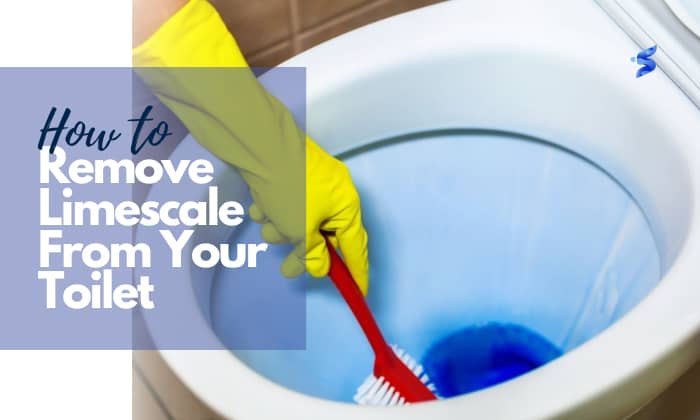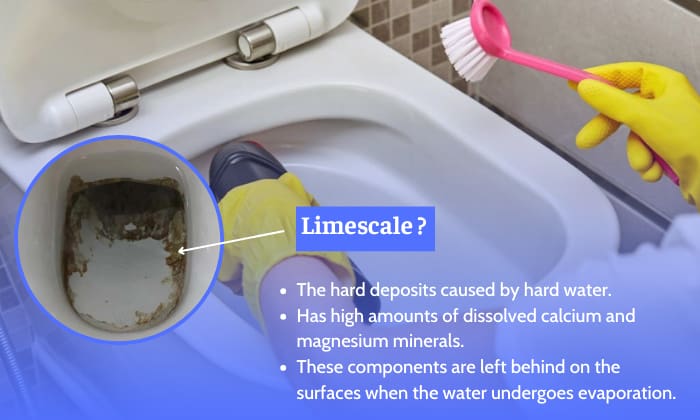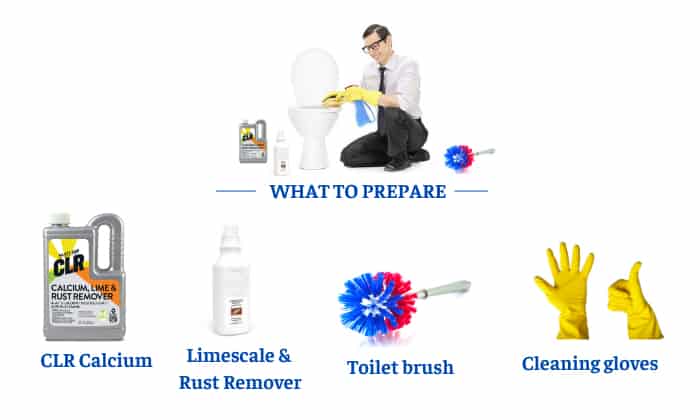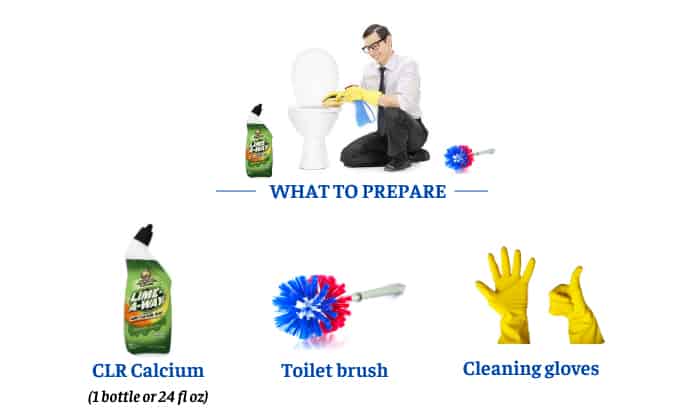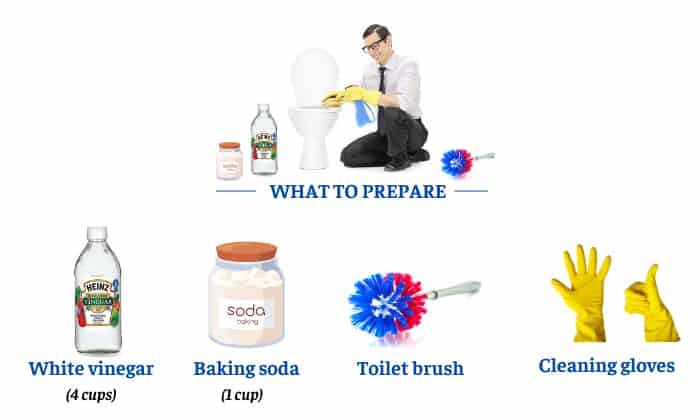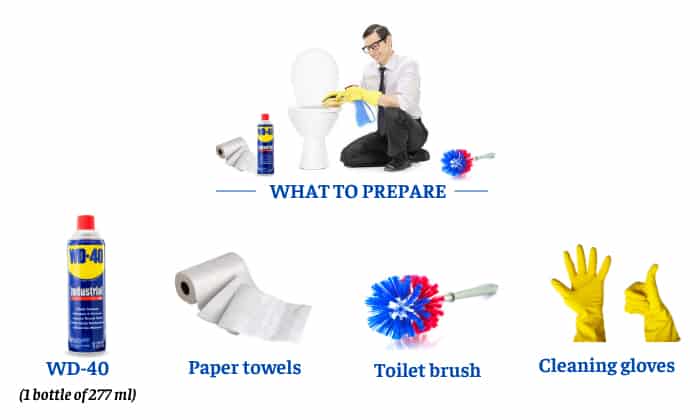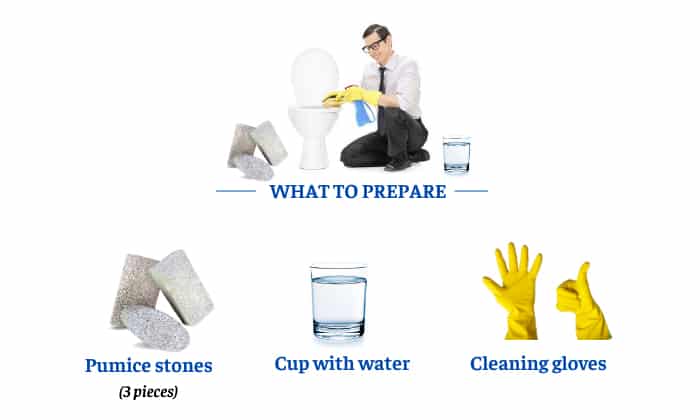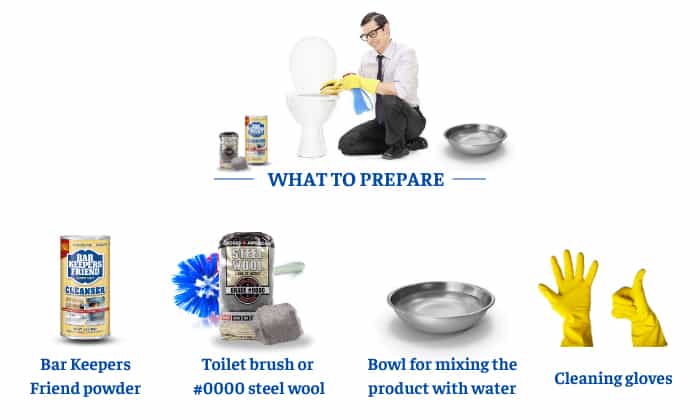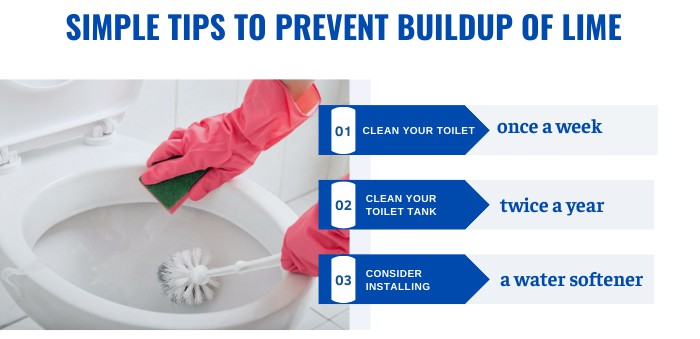You have a beautiful pristine bathroom in all areas, from the walls and furniture down to the floor; then you see the toilet bowl covered in brown and yellowish scum that’s starting to smell like something rotten.
This unsightly buildup is called limescale. The good news? We can eliminate it.
This article will teach you effective methods on how to remove limescale from your toilet. We also included recommendations to prevent lime buildup in the toilet.
Table of Contents
What is Limescale and Why Does It Build Up on the Toilet?
Limescale is the hard deposits caused by hard water, which has high amounts of dissolved calcium and magnesium minerals. These components are left behind on the surfaces when the water undergoes evaporation.
So, what causes hard water? When groundwater flows through porous rocks with high mineral content, these components will be dissolved and carried along the pipes to your water supply.
As such, when you flush the toilet with hard water, you’ll leave minerals on the porcelain. Once evaporated, these impurities stain your toilet with scummy and chalky limescale—usually white, grey, pink, or brown.
Is Hard Water Harmful to Health?
Hard water is not considered a health hazard by scientific studies, but it can be an inconvenience to your plumbing fixtures. That’s why in the next parts of this article, you’re going to discover how to clean limescale from the toilet.
6 Effective Ways to Get Rid of Limescale in the Toilet
When using commercial products to clean limescale in the toilet, always put on cleaning gloves beforehand. If the product exhumes heavy odors, consider wearing a face mask as well to protect your respiratory system.
Method 1: Use CLR Calcium, Limescale & Rust Remover
What to prepare:
- CLR Calcium, Limescale & Rust Remover (at least 1 cup)
- Toilet brush
- Cleaning gloves
CLR contains water and surfactants, plus lactic, glycolic, citric, sulfamic, and gluconic acids. This composition makes it one of the best commercial products to get limescale out of the toilet, but you should never combine it with bleach or other cleaners.
Steps:
- Turn off the shut-off valve and flush the toilet. You can use a towel to soak up the excess water in the bowl so the water level doesn’t go over the limescale.
- Pour 1 cup of CLR into the bowl so that it covers the limescale.
- Leave the product to rest for 2–5 minutes—any longer than this may damage the surface.
- Brush the bowl thoroughly until the stains are gone. If they don’t disappear on the first try, you may repeat the process. However, you must rinse the toilet first.
- Turn on the shut-off valve and flush to rinse off the CLR. If you’re trying to remove thick limescale, redo the steps again.
Method 2: Application of Lime-A-Way Liquid Toilet Bowl Cleaner
What to prepare:
- Lime-A-Way Liquid Toilet Bowl Cleaner (at least 1 bottle or 24 fl oz)
- Toilet brush
- Cleaning gloves
Lime-A-Way is designed specifically to remove hard water stains from a toilet bowl. Its ingredient list contains water, PEG-2 hydrogenated tallow amine, hydrochloric acid, acid blue 93, acid yellow 23, C10-16 pareth, and methyl salicylate.
Steps:
- Before we begin with Lime-A-Way, clean your toilet first with your regular cleaning routine to remove excess grime and dirt.
- Turn off the water supply and flush the bowl.
- After cleaning, squeeze Lime-A-Way around the toilet and make sure it soaks.
- Leave for 10 minutes.
- Brush the bowl; don’t be afraid to apply elbow grease. This product can remove even the severe limescale in the toilet.
- Turn on the water supply, then flush to rinse.
Method 3: Pour White Vinegar and Baking Soda
What to prepare:
- White vinegar (at least 4 cups)
- Baking soda (at least 1 cup)
- Toilet brush
- Cleaning gloves
Using vinegar and baking soda is a superb way to naturally get rid of brown limescale in the toilet. Vinegar is an acid, and baking soda is mildly abrasive; combining their characteristics can successfully break down hard water stains.
Steps:
- Turn off the shut-off valve and flush the toilet.
- To remove lime from the toilet, start by pouring 2 cups of white vinegar onto the limescale in the bowl.
- Use the toilet brush to spread the vinegar around the bowl, then let it sit for 1-2 minutes.
- Sprinkle 1 cup of baking soda into the bowl, then immediately pour 1 or 2 cups of white vinegar onto the powder.
- Let the mixture sit for 10 minutes.
- Scrub the bowl thoroughly, especially the hard water stains.
- Once done, leave the mixture for another 30 minutes.
- Turn on the shut-off valve, then flush the toilet to rinse the solution. Repeat the process if necessary.
Method 4: Wipe With WD-40 Multi-Use Product
What to prepare:
- WD-40 Multi-Use Product (at least 1 bottle of 277 ml)
- Toilet brush
- Paper towels
- Cleaning gloves
We know you’re about to ask, “Can WD-40 remove limescale from toilets?” The answer is yes. This product can soften lime deposits sitting in your bowl so you can brush them away later on.
Steps:
- Spray WD-40 on the areas with limescale.
- Wait for 2 minutes.
- With your toilet brush, scrub the bowl thoroughly.
- Once you’re done, grab a paper towel and wipe the toilet lime remover off the bowl.
Method 5: Scrub With Pumice Stones
What to prepare:
- Pumice stones (at least 3 pieces)
- Gloves
- Cup with water
Pumice stones are a simple but effective tool for removing limescale from the toilet. It’s mildly abrasive, so it can scrub hard water stains, but it’s also softer than the toilet’s porcelain, making it safe to use (as long as it’s wet!).
Steps:
- Perform your regular toilet cleaning routine to eliminate excess dirt or grime.
- To begin, dip the pumice stone in your cup of water, then proceed to scrub away the limescale.
- Make sure that the pumice is always wet before you use it to scrub the porcelain to avoid scratching it. And remember, pumice is good in lime removal from the toilet, but you will likely need more than 1 stone.
4. After the process, flush the toilet.
Method 6: Clean With Bar Keepers Friend Powder
What to prepare:
- Bar Keepers Friend powder
- Toilet brush or #0000 steel wool
- Bowl for mixing the product with water
- Cleaning gloves
Bar Keepers Friend is another staple in cleaning the toilet because of its oxalic acid. This chemical can remove stains such as rust and limescale by tackling them on a molecular level, breaking them down more aggressively.
Steps:
- Turn off the shut-off valve and flush the toilet. Manually take out the bowl’s water to prevent it from touching the limescale we must clean.
- Mix the Bar Keepers Friend powder with water until it creates a thick paste.
- Spread the paste around the limescale in the bowl with a brush or steel wool.
- Leave the paste for 5 minutes.
- Scrub the toilet well, focusing on the limescale.
- Turn on the shut-off valve, then flush the toilet to rinse the bowl. You may repeat the steps if necessary.
Things That Don’t Work in Removing Toilet Limescale
We are finished discussing what works in removing hard water stains—specifically limescale— from the toilet. Now, we’re going to tell you what DOESN’T work.
- A toilet cleaner manufactured for routine cleaning and disinfecting is not a strong enough product to remove limescale from the toilet. However, cleaning regularly will prevent limescale buildup.
- Bleach doesn’t clean the limescale; it just marginally lightens the stains. And using bleach may cause a reaction with the mineral content in the bowl.
Simple Tips to Prevent Buildup of Lime in Toilet
Having a limescale in your toilet is quite stressful. While there are a lot of products that can remove them, it’s best if we can prevent them from forming in the first place. Here’s how:
- Clean your toilet once a week to avoid limescale and bacteria buildup.
- Clean your toilet tank twice a year, as the water you use to flush the commode is stored in the tank. So, what happens when your tank is contaminated with mineral buildup?
- Consider installing a water softener, as this can effectively remove calcium and magnesium from your water supply.
Conclusion
Dealing with a toilet stained with hard water is not pleasing to the eyes and even the nose. But luckily, you now know how to remove limescale from your toilet.
We can use products specifically designed for eliminating limescale, such as CLR and Lime-A-Way. Multipurpose cleaners such as Bar Keepers Friend and WD-40 can also dissolve hard water stains.
Natural solutions, such as baking soda and white vinegar mixture, are likewise proven to work in removing those nasty brown limescale from the toilet’s porcelain surface.

I’m Paulk Webb, and I work as a writer for Saveourwaterrebates. I’m happy to put in the time and effort to conduct market research to identify the most pressing issues faced by households concerning their plumbing. Feel free to check out our guides to get the most informed recommendations for how to solve your problems.


